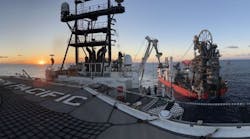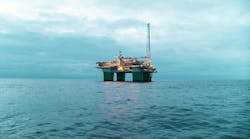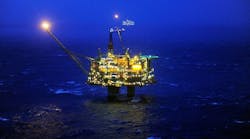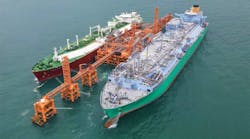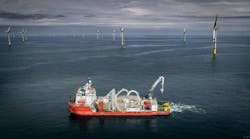Rank wildcats are a rare event these days in the UK North Sea. Many operators have drillable prospects, but lack the sanction from head office in Houston because wells cost less in the Gulf of Mexico and returns are higher off West Africa. Some UK-based companies are struggling to mount any new activity.
The UK Labor government also played its part two years ago by seeking to raise petroleum taxes at a time of jittery oil prices and mismatched rig rates. Having abandoned that course, it is now attempting to salvage the thousands of jobs at risk from waning UKCS activity. This has led to several new government-oil industry initiatives being launched.
As a successor to the cost-reduction body Crine, the industry established Logic last fall. In some ways, Logic is a Crine clone, with a stated aim of trimming £1 billion off UKCS drilling, capital expenditures and operating expenditures by 2002. The wider picture, however, includes fostering more creative contracting, new technologies, and greater take-up of e-commerce.
One of its latest thrusts is the "satellite accelerator" program. This challenges the engineering sector to put forward new concepts for developing stranded marginal or technically problematic field prospects. There are thought to be more than 300 undeveloped discoveries on the UKCS, around 240 of which have no declared development strategy.
Development schemes
A complementary initiative is the Undeveloped Discoveries Workgroup launched this June by another government/industry body called Pilot. This group is looking at ways of bringing together license owners of adjacent discoveries to explore new ways to speed up development. Several potential development clusters have already been identified.
Pilot has also contracted the British Geological Survey and web technology specialist ESRI to compile a Digital Energy Atlas and Library. This should be a comprehensive, web-site database of exploration and production prospects - the key aim being, speed up the data search process. Last month, the government also announced what it claims is the world's first web-based system for oil production reporting, which has just been trialed on Shell's Eider and BG's Neptune fields.
Independently from the government, the operators have been sharing their mistakes and successes over the internet, where possible. One popular site is Link (Lessons and Incidents Networked equals Knowledge), assembled by drilling and completions specialists. A BP Amoco team working on the Bruce Field in the North Sea identified a way of flushing well-test surface lines off their critical path, thereby saving 12 hours of rig time, equivalent to $100,000. This approach was subsequently picked up on (via Link) by the West of Shetland division plus other BP Amoco units outside Britain.
Petroweb is another internet service, founded in Aberdeen three years ago by two ex-Shell engineers. Their clientele has expanded to 13 UKCS operators, plus JNOC and Baker Hughes. Petroweb is described as an independent knowledge-sharing service company, covering the entire well operations process cycle, which facilitates exchange of experience, lessons learned and best practices.
Participants will openly relay their mistakes, including equipment failures, often in surprising detail, given the constraints on well engineering time. Their supervisors may tolerate it, Petroweb Director Harry van Vossen suggests, "because 50% of oil companies' expenditure goes on drilling and completing wells."
"Minimal" wells
One of Crine's final acts, in June 1998, was a project launched with the operators association UK called "Double the Value of Wells by 2000." Phase 1 of this program, designated "Finder Wells," was completed last year, and has already delivered results in the central and southern North Sea.
A "finder" well is defined as an exploratory wildcat aimed purely at determining the presence or absence of significant hydrocarbons. Costs are contained through:
- Multi-discipline teams working together to fully define the objectives of the well early on, with "no change" orders during drilling
- Incorporation of lessons learned from best practice elsewhere
- Minimal formation evaluation
- Accepting higher risk in the design of the well.
The dictum on formation evaluation generated the most intense debate. Historically, geoscientists, reservoir engineers, and govern- ments have accumulated vast quantities of data while drilling, relating to multiple wireline logging runs, drillstem tests, side wall cores, vertical seismic profiles, and so on - all adding to rig time.
Under the finder approach, however, there is a clampdown on this process. Crine pointed out that a single logging run over the objective interval should answer the key question: "Are hydrocarbons present or not?" Most of these wells would likely have no significant end-product, but where the outcome is successful, Crine argued, more comprehensive data could be collated through subsequent appraisal drilling.
Accepting higher risk means under-elaborating on well design, without compromising safety.
For example, casing strings can be eliminated or holes drilled using smaller diameter wellbores. Perhaps one in ten of these type of wells will fail to reach its objective. On the other hand, Crine suggested, the resultant savings on the other nine should allow the operator to re-drill one of 10 wells and still save money on the overall program. Crine claimed these measures could cut overall well costs on the UK shelf by 50%, allowing more exploratory wells to be drilled.
One of the first wells adopting the new methodology was drilled by Mobil in September 1998 in Tranche 6, off northwest Scotland in 3,400 ft water depths. The aims included full evaluation of all potential hydrocarbon-bearing zones and to gain wider understanding of the geological setting in this frontier play. The well was designed to give the maximum chance of reaching the 10,000 ft commitment depth, with contingency being given to unknown shoe strength.
The combination of deepwater, harsh environment, and ocean currents necessitated a conservative well design, including a special riser and fairings. Water-based mud was chosen for environmental reasons. Rig operating costs were unsurprisingly high, so incremental costs associated with coring and additional wireline logging were kept low.
Mobil concluded afterwards that the main costs associated with wells in this area came from being in a position to drill safely and efficiently. Future wells, it suggested, could be drilled in the summer months using a riser without fairings, and with a scaled-down formation evaluation. Such measures could cut well costs in deepwater by up to 30%, Mobil predicted.
Last year, Conoco gained two discoveries using the Finder method. One discovery, Vixen, is a 117 bcf gas field off the Lincolnshire coast which has been put on a fast-track development schedule as a subsea satellite of the Viking B platform. The other, Kappa, is an oil and gas accumulation in the Moray Firth, within touching distance of the Britannia platform. The well encountered a total hydrocarbon column of 150 ft. It was logged, but was not production tested. Instead, an appraisal well will be drilled later this year.
Conoco also plans to drill what it calls "snuggle" exploratory wells on the Venus and K prospects in the southern North Sea. According to John Williams, General Manager, Exploration, these are wells that are "close to infrastructure, have a high net present value per barrel, have low risk, and can be developed quickly if successful."
Wellsite innovations
Amerada Hess' latest discovery in the Outer Moray Firth, Rochelle, was also its closest to the Finder model. An earlier discovery in the same region, called Goldeneye, nearly fitted the bill, except that coring was performed in advance. Rochelle is an oil and gas accumulation in Early Cretaceous Kopevik sands, within tieback distance of Amerada's semisubmersible platform AH001 which currently produces the Renee and Rubie fields. Drilling, performed by the Stena Spey, was completed ahead of schedule this April. The reservoir target depth of 10,500 ft was reached in just 14 days.
These results were achieved through a combination of early and integrated well planning. Industry best practice was adopted in the form of a slimmed down casing design and the choice of a motor above the bit to reduce downhole vibration while drilling through chalk. This allowed Amerada to keep its top of the range measurement-while-drilling and logging tools running, while also achieving a high rate of penetration. Previously, the company had had a history of tool failure drilling through chalk. "This time, we managed to acquire information across the zones of interest," says an Amerada spokesman. This was also the fastest we've ever drilled across 10,000 ft."
Although the location was hardly remote, Amerada's management apparently will approve exploratory wells in uncertain areas, the spokesman says, provided that costs can be kept down. "Why spend a lot of money on casing the well, with fancy architecture, when you don't actually know if oil is there? The North Sea is littered with these types of dry holes."
Amerada aims to achieve 50% cost savings on its UKCS wells and also accelerate access to small accumulations. Key to this strategy is its new in-house program called To the Limit (T2L). This is derived from a scheme pioneered by Woodside on Australia's North West Shelf in 1994, called Technical Limit, subsequently adopted in different guises by Shell - Delivering the Limit - and BP Amoco's Theoretical Maximum Performance.
Maximum performance
"The T2L concept basically asks, how quickly can you get from A to B?" says Amerada Hess Well Superinten-dent Dave Taylor. "Sometimes, you will set up two to three assemblies to drill bottomhole sections for lithological considerations. That's been considered acceptable up to now. T2L questions, however, whether we really need to follow such courses; if the answer is 'yes,' can we do it on a critical path or can we do it in half the time?"
The new approach requires staff at all levels to question pre-conceived notions, then put forward innovations to aid the drilling process - and not to feel slighted if their views aren't heeded immediately. "We've also created an environment where drilling people can put their hand up and say, 'I made an error,'" Taylor points out. "And that's OK. We've trained 300 people in this new enabling environment. So for example, if we drill a well in 12 days, we ask them "tell us how we can do it in 11.2 days next time."
Ideas that have already been implemented, and paid off, include greater use of pre-assembled bottomhole assemblies with cement wipers plugs pre-installed. Amerada has also switched to pre-hydrated bentonite mud, as the dehydration process was slowing down parallel drilling activities. And without compromising safety, it has established drills for blowout preventers that prove the system's integrity, allowing the previous regime of extended testing to be dispensed with.
Amerada may apply T2L for a forthcoming shallower water well in the UK North. It is also extending the concept to its suppliers, under a program called Procurement Support for T2L. "There is some perception among service companies that improvements are only to Amerada's benefit," Taylor says. "But if we can involve them to help us drill even cheaper wells, we can also drill more of them, which in turn helps the supply industry."



